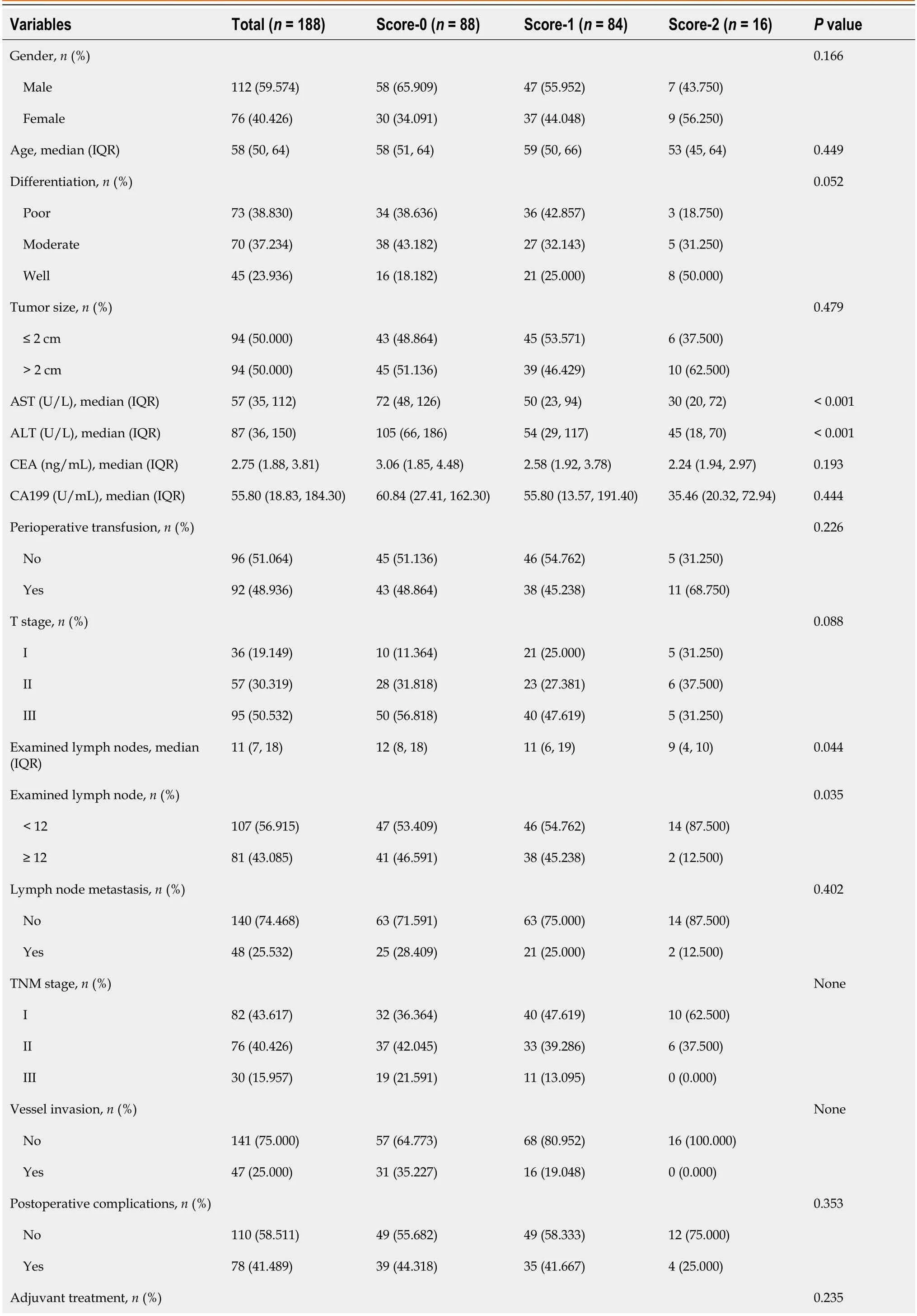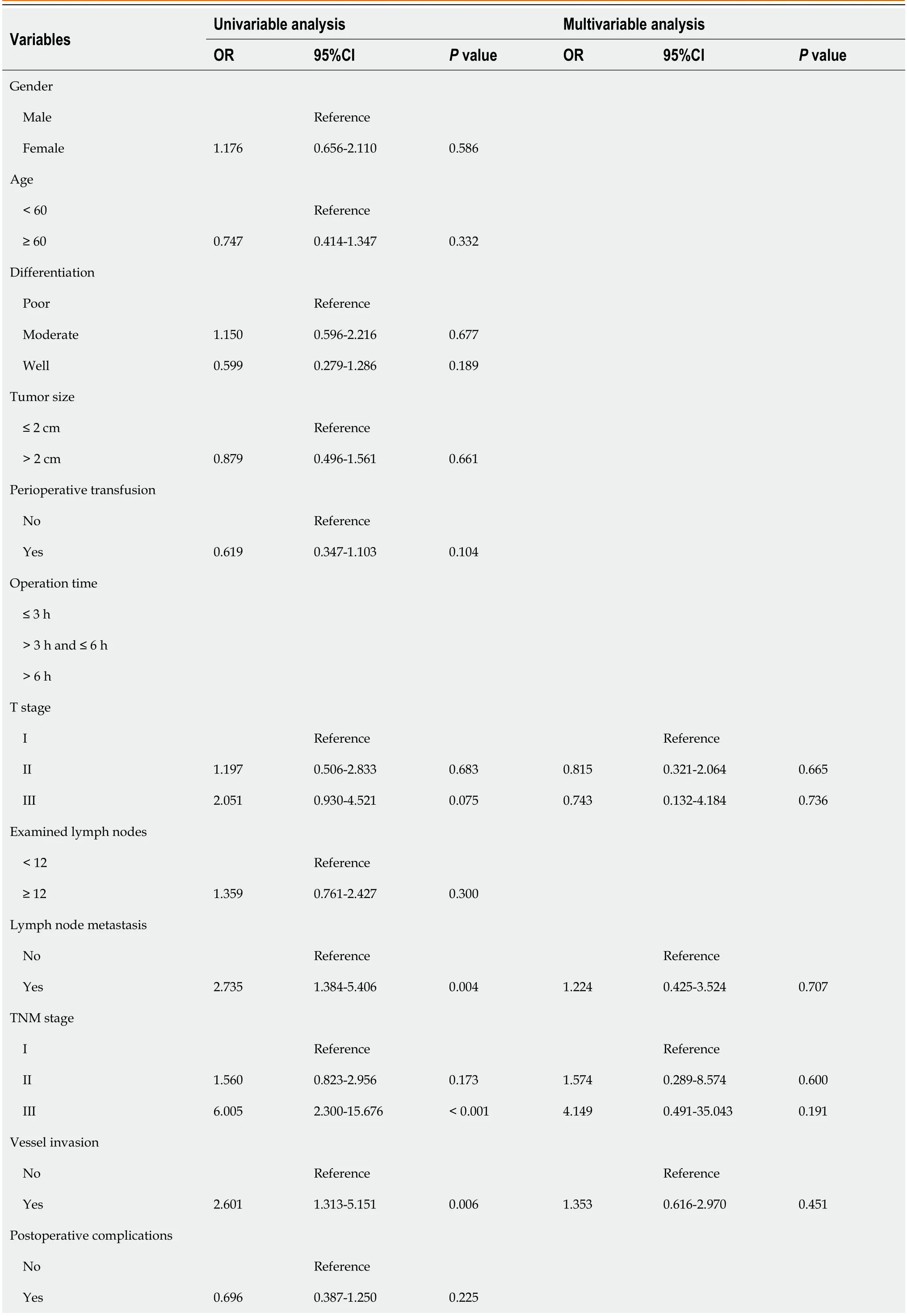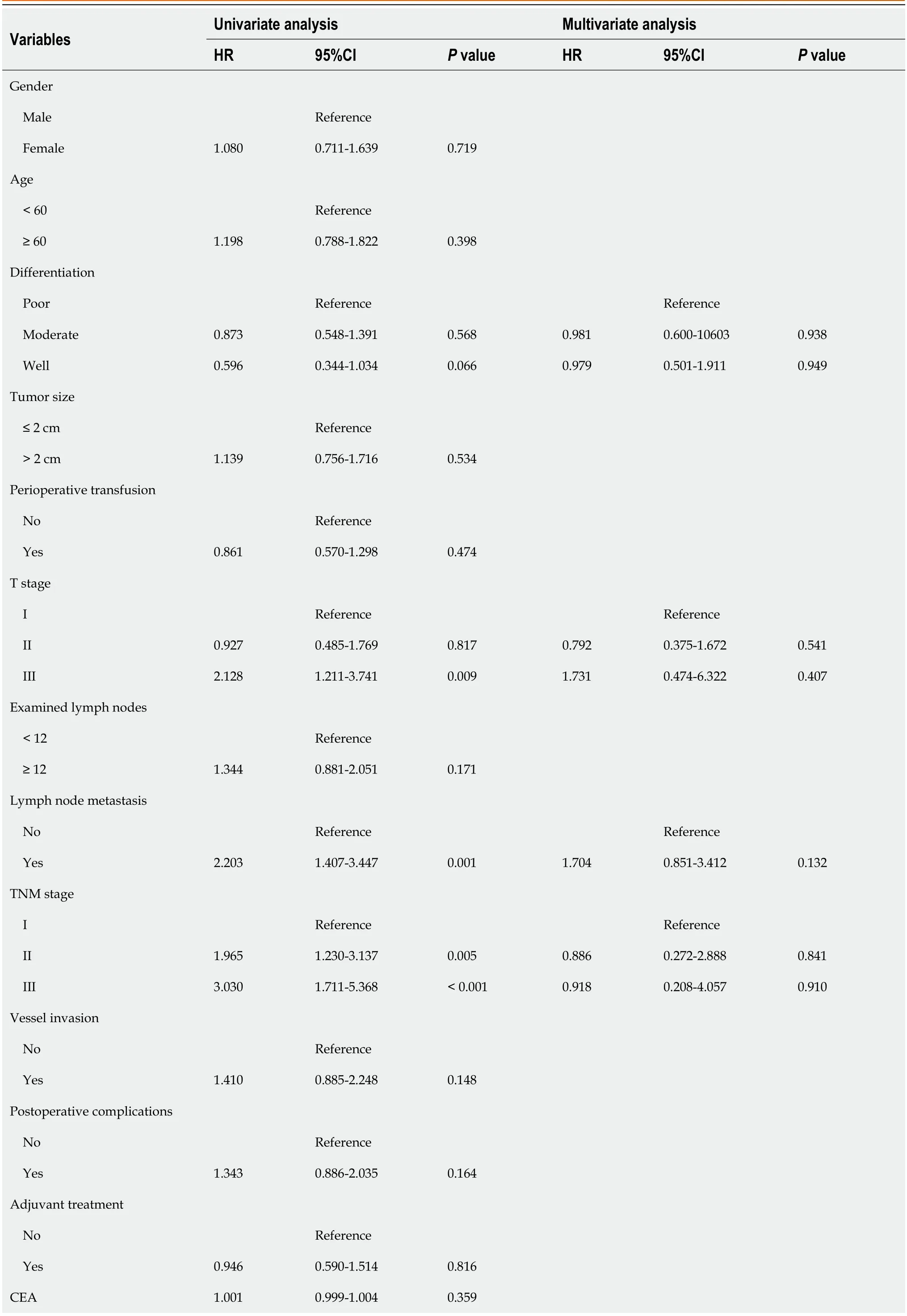Novel prognostic score based on the preoperative total bilirubinalbumin ratio and fibrinogen-albumin ratio in ampullary adenocarcinoma
Xiao-Jie Zhang,He Fei,Chong-Yuan Sun,Ze-Feng Li,Zheng Li,Chun-Guang Guo,Dong-Bing Zhao
Abstract BACKGROUND The preoperative total bilirubin-albumin ratio (TBAR) and fibrinogen-albumin ratio (FAR) have been proven to be valuable prognostic factors in various cancers.AIM To detect the prognostic value of TBAR and FAR in ampullary adenocarcinoma(AC) patients who underwent curative pancreaticoduodenectomy.METHODS AC patients who underwent curative pancreaticoduodenectomy in the National Cancer Center of China between 1998 and 2020 were retrospectively reviewed.The prognostic cutoff values of TBAR and FAR were determined through the best survival separation model.Then,a novel prognostic score combining TBAR and FAR was calculated and validated through the logistic regression analysis and Cox regression analysis.RESULTS A total of 188 AC patients were enrolled in the current study.The best cutoff values of TBAR and FAR for predicting overall survival were 1.7943 and 0.1329,respectively.AC patients were divided into a TBAR-low group (score=0) vs a TBAR-high group (score=1) and a FAR-low group (score=0) vs a FAR-high group (score=1).The total score was calculated as a novel prognostic factor.Multivariable logistic regression analysis revealed that a high score was an independent protective factor for recurrence [score=1 vs score=0: Odds ratio(OR)=0.517,P=0.046;score=2 vs score=0 OR=0.236,P=0.038].In addition,multivariable survival analysis also demonstrated that a high score was an independent protective factor in AC patients (score=2 vs score=0:Hazard ratio=0.230,P=0.046).CONCLUSION A novel prognostic score based on preoperative TBAR and FAR has been demonstrated to have good predictive power in AC patients who underwent curative pancreaticoduodenectomy.However,more studies with larger samples are needed to validate this conclusion.
Key Words: Ampullary adenocarcinoma;Total bilirubin-albumin ratio;Fibrinogen-albumin ratio;Recurrence;Overall survival
INTRODUCTION
Ampullary adenocarcinoma (AC) is an uncommon malignant digestive adenocarcinoma and accounts for approximately 0.2% of all digestive malignancies[1].Radical surgery is the only potential curative treatment for AC patients[2].It has been reported that the 5-year survival rate of AC patients after surgery is 45%,and postoperative recurrence and metastasis are the main factors affecting the prognosis of AC patients[1,3].Unfortunately,effective prognostic predictors are still lacking,especially perioperative peripheral blood biomarkers.
Preoperative total bilirubin (TB) is a critical biomarker for the diagnosis of biliary obstruction and is present at the first diagnosis for the majority of AC patients.In addition,preoperative albumin has been widely used for defining immune and nutritional statuses[4].Recently,several studies have proven that the preoperative fibrinogen-albumin ratio (FAR) is a significant prognostic biomarker in multiple tumor types,including lung cancer[5],hepatocellular carcinoma[6],colorectal cancer[7],gastric cancer[8],bladder cancer[9],and rectal cancer[10].However,whether the relationship of preoperative TB,fibrinogen,and albumin could be used as prognostic factors is still debated.Therefore,in the current study,we aimed to explore the relationship among the preoperative TB-albumin ratio (TBAR),FAR,and long-term prognosis in AC patients based on a high-volume retrospective cohort in the National Cancer Center of China.
MATERIALS AND METHODS
Patients
AC patients who received curative surgery at the National Cancer Center of China between 1998 and 2020 were retrospectively reviewed.The main inclusion criteria were as follows: (1) Patients who were pathologically confirmed as having AC;(2) patients who received pancreaticoduodenectomy;and (3) patients with negative surgical margins.The main exclusion criteria were as follows: (1) Patients who died within one month after surgery;(2) patients who were lost to follow-up;(3) patients whose critical clinical information was missing;and (4) patients for whom preoperative TBAR and FAR were unavailable.As this was a retrospective cohort study,ethical exemption and informed consent exemption were obtained from the Ethics Committee of Cancer Hospital,Chinese Academy of Medical Sciences and Peking Union Medical College.
Calculation of preoperative TBAR and FAR
The TBAR was calculated as preoperative TB (μmol/L) divided by preoperative albumin (g/L).The FAR was calculated as preoperative fibrinogen (g/L) divided by preoperative albumin (g/L).
Follow-up
The postoperative follow-up was performed through telephone review,clinic visits,and the death registration system.The last follow-up time was December 2021.None of the patients was lost to follow-up.The median follow-up time was 36 mo.
Statistical analysis
All categorical variables are expressed as frequencies (percentages),and continuous variables are expressed as medians(interquartile ranges).Theχ2test or Fisher’s exact test was used for comparison of categorical variable groups,and the Mann-WhitneyUtest was used for comparison of continuous variable groups.The cutoff values of TBAR and FAR were calculated by the best survival separation model through the “Survival” and “Survminer” packages in R software(version 4.0.3).The correspondingPvalue and hazard ratio (HR) were calculated one by one with each TBAR and FAR value as the cutoff value by setting a cycle.When thePvalue was the smallest,the cutoff TBAR and FAR values were the best survival separation cutoff values.The correlations between preoperative carbohydrate antigen 199 (CA199),carcinoembryonic antigen (CEA),alanine aminotransferase (ALT),aspartate aminotransferase (AST),TBAR,and FAR were conducted by Spearman analysis.Univariable and multivariable Cox regression analyses were performed to validate the independent prognostic factors.Variables withP< 0.1 in the univariable survival analysis were included in the multivariable survival analysis.The results in the present study are described as HRs,95% confidence intervals (CIs),andPvalues.APvalue less than 0.05 was considered statistically significant.All statistical analyses were performed using R software (version 4.0.3).
RESULTS
Baseline characteristics
In total,188 AC patients were enrolled in the study,with an overall male:female ratio of 1.47.Overall,nearly a quarter of patients had lymph node metastasis.Since all patients underwent open pancreaticoduodenectomy and the surgical trauma was relatively large,nearly half of the patients received intraoperative blood transfusion.In addition,a total of 54 patients (28.72%) received postoperative adjuvant therapy.The detailed baseline clinicopathologic characteristics of AC patients in the current study are illustrated in Table 1.

Table 1 Comparing the baseline characteristics of different score groups in ampullary adenocarcinoma
Cutoff values of TBAR and FAR
The cutoff values of TBAR and FAR were calculated through the best survival separation model.In the current study,the cutoff value of TBAR was 1.7943,while the cutoff value of FAR was 0.1329 (Figure 1).Furthermore,we conducted correlations between preoperative CA199,CEA,ALT,AST,TBAR,and FAR.The results demonstrated that FAR was significantly correlated with preoperative AST,ALT,and CA199,while TBAR was signi-ficantly correlated with preoperative AST,ALT,CEA,and CA199 (Figure 2,Supplementary Tables 1 and 2).
Total score combining the TBAR and FAR
In the current study,we defined TBAR-low and FAR-low as score 0 and TBAR-high and FAR-high as score 1.Directly after,we calculated the total score and classified all the patients into the score-0 group,score-1 group,and score-2 group.By comparing the baseline clinicopathologic data,we found that there were no significant differences among the three groups in tumor stage,tumor differentiation degree,tumor size,CA199 level,CEA level,or postoperative adjuvant therapy (Table 1).
Survival analysis
The 1-year,3-year,and 5-year overall survival (OS) rates were 91.3%,63.6%,and 41.7%,respectively.According to the univariable survival analysis,the TBAR-high group,FAR-high group,and score-high group had better prognoses(Figure 3).In the multivariable logistic regression analysis,score 1 [odds ratio (OR)=0.517;95%CI: 0.270-0.988;P=0.046)and score 2 (OR=0.236;95%CI: 0.060-0.922;P=0.038] were independent protective factors for tumor recurrence(Table 2).However,in the multivariable survival analysis,a high score was not an independent factor for recurrence-free survival (RFS) (P> 0.05) (Supplementary Table 3).Furthermore,we conducted multivariable OS analysis and found that only the score-2 group was an independent protective factor for OS (HR=0.230;95%CI: 0.054-0.972;P=0.046) (Table 3).

Figure 3 Comparing the Kaplan-Meier survival curves of different groups divided by total bilirubin-albumin ratio,fibrinogen-albumin ratio and total score. A: Total bilirubin-albumin ratio;B: Fibrinogen-albumin ratio;C: Total score.TBAR: Total bilirubin-albumin ratio;FAR: Fibrinogen-albumin ratio;OS:Overall survival.

Table 2 Univariate and multivariate logistic analysis of independent factors predicting the tumor recurrence

Table 3 Univariable and multivariable Cox regression analysis of overall survival time in ampullary adenocarcinoma
DISCUSSION
Most previous studies separately analyzed the prognostic value of preoperative TB,fibrinogen,and albumin for solid tumors,and the results from different cohorts are still controversial.After inclusion of these predictors,we found that TBAR combined with the FAR was an independent predictor for tumor recurrence and an independent protective factor for OS in AC patients.These peripheral blood biomarkers could be used as prognostic factors and are novel,reliable,economic,and easily accessible biomarkers for advanced AC.
The hemostatic system can regulate angiogenesis in various ways.Fibrinogen is an extracellular matrix protein composed of three polypeptide chains with fibrinogen alpha,beta,and gamma.Recent studies have shown that the FARis associated with prognosis in several solid malignancies,including pancreatic neuroendocrine neoplasms[11] and gastrointestinal stromal tumors[12].FAR is considered a feasible and predictive biomarker for prognosis in patients.In addition,Zhang and Xiao[13] revealed that the FAR was significantly associated with deeper tumor invasion and increased regional lymph node involvement.However,Zhaoet al[14] showed that fibrinogen-derived fibrinostatin has antiangiogenic activity by inhibiting endothelial cell proliferation,adhesion,migration and tubule formation.By inducing apoptosis and inhibiting epithelial-mesenchymal transition,alpha may suppress lung adenocarcinoma cell growth andmetastasis[15].Nevertheless,the specific mechanism of the relationship between the FAR and prognosis still needs to be investigated further.
Bilirubin is one of the routine biochemical testing items,which originates primarily from circulating hemoglobin and is the most important product of hemoglobin decomposition.It has antioxidant properties and can protect cells against oxidative stress as an endogenous antioxidant[16].Sunet al[17] found that decreases in serum bilirubin levels are associated with poorer prognoses in some types of cancer through antioxidant activity.Another study also revealed that high serum bilirubin was related to low cancer mortality[18].However,Fenget al[19] demonstrated that baseline bilirubin and serum proteins were not associated with the prognosis of advanced pancreatic cancer.Instead,a Japanese study indicated that a low albumin-bilirubin (ALBI) grade is related to better OS and RFS in esophageal cancer patients[20].AC will directly affect the biliary tract,and the presence of jaundice can predict malignant ampullary strictures[21];thus,their disease may be diagnosed at an earlier stage.
Albumin is a secretory protein produced only by functional hepatocytes,and it reflects the chronic nutritional state,which is commonly used for nutritional status assessment.The nutritional state of cancer patients was associated with unfavorable outcomes in malignant tumor patients.Our score is a composite indicator containing representative results of biochemical analysis,which can reflect the nutritional and inflammatory status,liver function and tumor effect.FAR in conjunction with TBAR has the potential to assist clinicians in the stratification of patients.Nevertheless,further investigation is still needed for the application of the novel score in clinical practice.
The traditional Child-Pugh grade used to assess liver function faces several inherent limitations.Therefore,Johnsonet al[22] developed a simple model based on albumin and bilirubin levels alone,the ALBI grade,which can stratify patients into three risk categories and objectively prognosticate survival.A meta-analysis demonstrated that high pretreatment ALBI is closely associated with poor prognosis in hepatocellular cancer[23].The ALBI grade also showed improved discriminatory ability in pancreatic cancer[24] and colorectal cancer[25].Our new score adds the blood coagulation index and broadens the use of AC.In addition,the score is easily calculated compared with the ALBI grade and increases versatility and usefulness.
High scores were independent factors for RFS in the univariable survival analysis but not in the multivariable analysis.Although there were some differences in RFS,these were not statistically significant.Furthermore,we conducted multivariable OS analysis and found that only the score-2 group was an independent protective factor for OS.Such conflicting results might be related to several factors.First,patients with higher scores might be more likely to detect recurrence earlier and receive more aggressive treatment as a result.Consequently,this might not significantly affect RFS but could emerge as an independent prognostic factor for OS.Second,the number of patients in the score-high groups was relatively small,and it might be challenging to detect statistically significant differences in RFS.Third,the inclusion of other prognostic factors in the model might have resulted in multicollinearity or confounding effects,which could attenuate the initial observed relationship between the score-high groups and RFS.These results emphasize the need for further research,potentially involving larger patient cohorts to comprehensively understand the underlying mechanisms and relationships between the scoring system and different survival outcomes.
During tumor growth,tumor markers are produced and released into the blood circulation,which can be used for the diagnosis and monitoring of tumors.However,sensitive tumor markers are still lacking for predicting survival and treatment outcomes in AC[26].In recent years,liquid biopsies have been increasingly emphasized.Circulating tumor DNA (ctDNA) derived from tumors is being used in analyzing prognosis and tumor burden in some solid tumors.Patelet al[27] found that higher levels of total ctDNA were an independent prognostic factor for worse survival for patients with advanced pancreatic ductal adenocarcinoma.However,this new technique can be limited by the small amounts of circulating biomarkers,and not everyone has detectable ctDNA levels[28].To date,liquid biopsy is a complement to tissue biopsy,and more research studies are needed for the improvement of clinical applications.They are not considered to be perfect predictors for the above reasons.Therefore,our new scoring system contained three common indicators andshowed great predictive power in AC patients who underwent curative pancreaticoduodenectomy.The novel score is expected to become a new biomarker for identifying poor prognosis in patients with AC.
There were limitations to this study.First,this was a single-center retrospective study with a relatively small sample,and multicentric prospective studies with large samples are needed in the future.Second,we did not perform a cohort verification of the results,and external validation is needed.Third,we did not investigate whether the postoperative peripheral blood biomarkers could be used as prognostic factors and analyzed the dynamic changes in the three indicators.Future research can evaluate the impact of these changes in great depth.
CONCLUSION
The novel prognostic score based on the preoperative TBAR and FAR was an independent predictor for tumor recurrence and an independent protective factor for OS in AC patients who underwent curative pancreaticoduodenectomy.However,more studies with larger samples are needed to validate this conclusion.
ARTICLE HIGHLIGHTS
Research background
Whether the relationship of preoperative total bilirubin,fibrinogen,and albumin could be used as prognostic factors is still debated.
Research motivation
The present study attempted to explore the prognostic value of total bilirubin-albumin ratio (TBAR) and fibrinogenalbumin ratio (FAR) in ampullary adenocarcinoma (AC) patients who underwent curative pancreaticoduodenectomy.
Research objectives
This study aimed to investigate whether there was an association between the novel prognostic score and poor oncologic outcomes in ampullary carcinoma.
Research methods
The clinicopathological data of ampullary carcinoma patients who underwent surgery from January 1998 to January 2020 were analyzed.Then,a novel prognostic score combining TBAR and FAR was calculated and validated through logistic regression analysis and Cox regression analysis.
Research results
Multivariable logistic regression analysis revealed that a high score was an independent protective factor for recurrence.In addition,multivariable survival analysis also demonstrated that a high score was an independent protective factor in AC patients.
Research conclusions
We found that the novel prognostic score based on the preoperative TBAR and FAR has good predictive power in AC patients who underwent curative pancreaticoduodenectomy.
Research perspectives
There are several limitations in this retrospective study,and more studies with larger samples are needed to validate this conclusion.
FOOTNOTES
Author contributions:Zhang XJ and Fei H contributed equally to this work;Guo CG and Zhao DB designed the research study,they are the corresponding authors of this paper;Fei H and Zhang XJ analyzed the data;all authors wrote the manuscript;and all authors have read and approved the final manuscript.
Institutional review board statement:Ethical review and approval were not required for the study on human participants in accordance with the National Cancer Center/National Clinical Research Center for Cancer/Cancer Hospital,Chinese Academy of Medical Sciences and Peking Union Medical College.
Informed consent statement:Ethical review and approval were not required for the study on human participants in accordance with the local legislation and institutional requirements.
Conflict-of-interest statement:All the authors report no relevant conflicts of interest for this article.
Data sharing statement:No additional data are available.
Open-Access:This article is an open-access article that was selected by an in-house editor and fully peer-reviewed by external reviewers.It is distributed in accordance with the Creative Commons Attribution NonCommercial (CC BY-NC 4.0) license,which permits others to distribute,remix,adapt,build upon this work non-commercially,and license their derivative works on different terms,provided the original work is properly cited and the use is non-commercial.See: https://creativecommons.org/Licenses/by-nc/4.0/
Country/Territory of origin:China
ORCID number:Xiao-Jie Zhang 0000-0001-9850-9806;He Fei 0000-0003-4831-4028;Chong-Yuan Sun 0000 0003 1354 2063;Ze-Feng Li 0000-0002-5345-3527;Zheng Li 0000-0003-4415-6552;Chun-Guang Guo 0000-0002-2674-6586;Dong-Bing Zhao 0000-0002-6770-2694.
S-Editor:Wang JJ
L-Editor:A
P-Editor:Wang JJ
 World Journal of Gastrointestinal Surgery2023年10期
World Journal of Gastrointestinal Surgery2023年10期
- World Journal of Gastrointestinal Surgery的其它文章
- Gastric adenosquamous carcinoma with an elevated serum level of alpha-fetoprotein: A case report
- Giant dedifferentiated liposarcoma of the gastrocolic ligament: A case report
- Hereditary hemorrhagic telangiectasia involving portal venous system: A case report and review of the literature
- Mucocutaneous ulcer positive for Epstein-Barr virus,misdiagnosed as a small bowel adenocarcinoma: A case report
- Three-dimensional computed tomography reconstruction diagnosed digestive tract perforation and acute peritonitis caused by Monopterus albus: A case report
- Postpolypectomy syndrome without abdominal pain led to sepsis/septic shock and gastrointestinal bleeding: A case report
